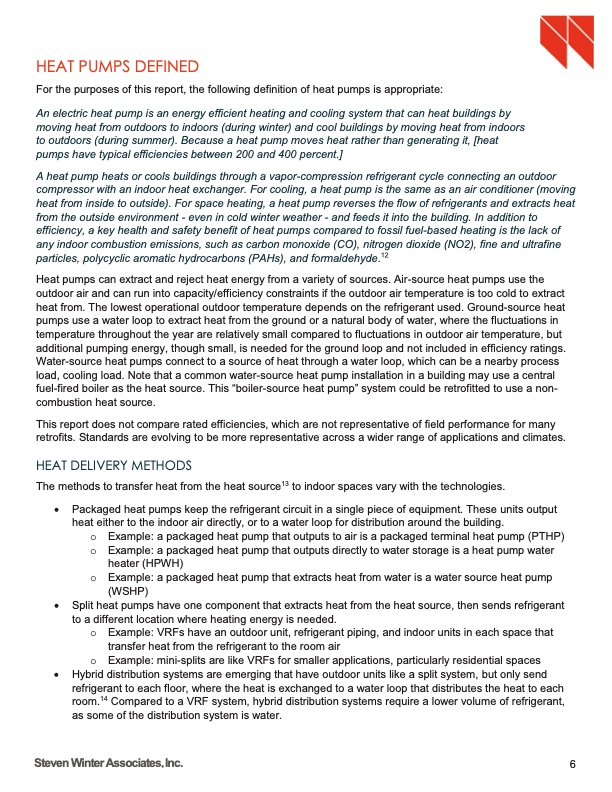
PDF Publication Title:
Text from PDF Page: 006
HEAT PUMPS DEFINED For the purposes of this report, the following definition of heat pumps is appropriate: An electric heat pump is an energy efficient heating and cooling system that can heat buildings by moving heat from outdoors to indoors (during winter) and cool buildings by moving heat from indoors to outdoors (during summer). Because a heat pump moves heat rather than generating it, [heat pumps have typical efficiencies between 200 and 400 percent.] A heat pump heats or cools buildings through a vapor-compression refrigerant cycle connecting an outdoor compressor with an indoor heat exchanger. For cooling, a heat pump is the same as an air conditioner (moving heat from inside to outside). For space heating, a heat pump reverses the flow of refrigerants and extracts heat from the outside environment - even in cold winter weather - and feeds it into the building. In addition to efficiency, a key health and safety benefit of heat pumps compared to fossil fuel-based heating is the lack of any indoor combustion emissions, such as carbon monoxide (CO), nitrogen dioxide (NO2), fine and ultrafine particles, polycyclic aromatic hydrocarbons (PAHs), and formaldehyde.12 Heat pumps can extract and reject heat energy from a variety of sources. Air-source heat pumps use the outdoor air and can run into capacity/efficiency constraints if the outdoor air temperature is too cold to extract heat from. The lowest operational outdoor temperature depends on the refrigerant used. Ground-source heat pumps use a water loop to extract heat from the ground or a natural body of water, where the fluctuations in temperature throughout the year are relatively small compared to fluctuations in outdoor air temperature, but additional pumping energy, though small, is needed for the ground loop and not included in efficiency ratings. Water-source heat pumps connect to a source of heat through a water loop, which can be a nearby process load, cooling load. Note that a common water-source heat pump installation in a building may use a central fuel-fired boiler as the heat source. This “boiler-source heat pump” system could be retrofitted to use a non- combustion heat source. This report does not compare rated efficiencies, which are not representative of field performance for many retrofits. Standards are evolving to be more representative across a wider range of applications and climates. HEAT DELIVERY METHODS The methods to transfer heat from the heat source13 to indoor spaces vary with the technologies. � Packaged heat pumps keep the refrigerant circuit in a single piece of equipment. These units output heat either to the indoor air directly, or to a water loop for distribution around the building. o Example:apackagedheatpumpthatoutputstoairisapackagedterminalheatpump(PTHP) o Example:apackagedheatpumpthatoutputsdirectlytowaterstorageisaheatpumpwater heater (HPWH) o Example:apackagedheatpumpthatextractsheatfromwaterisawatersourceheatpump (WSHP) � Split heat pumps have one component that extracts heat from the heat source, then sends refrigerant to a different location where heating energy is needed. o Example:VRFshaveanoutdoorunit,refrigerantpiping,andindoorunitsineachspacethat transfer heat from the refrigerant to the room air o Example:mini-splitsarelikeVRFsforsmallerapplications,particularlyresidentialspaces � Hybrid distribution systems are emerging that have outdoor units like a split system, but only send refrigerant to each floor, where the heat is exchanged to a water loop that distributes the heat to each room.14 Compared to a VRF system, hybrid distribution systems require a lower volume of refrigerant, as some of the distribution system is water. Steven Winter Associates,Inc. 6PDF Image | HEAT PUMP RETROFIT STRATEGIES FOR MULTIFAMILY BUILDINGS

PDF Search Title:
HEAT PUMP RETROFIT STRATEGIES FOR MULTIFAMILY BUILDINGSOriginal File Name Searched:
heat-pump-retrofit-strategies-report-05082019.pdfDIY PDF Search: Google It | Yahoo | Bing
CO2 Organic Rankine Cycle Experimenter Platform The supercritical CO2 phase change system is both a heat pump and organic rankine cycle which can be used for those purposes and as a supercritical extractor for advanced subcritical and supercritical extraction technology. Uses include producing nanoparticles, precious metal CO2 extraction, lithium battery recycling, and other applications... More Info
Heat Pumps CO2 ORC Heat Pump System Platform More Info
| CONTACT TEL: 608-238-6001 Email: greg@infinityturbine.com | RSS | AMP |